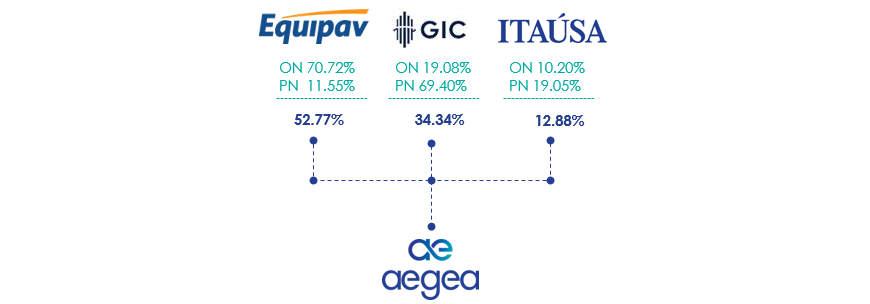OVERVIEW
A clear corporate governance structure that helps us detect and control possible risks, as well as seize opportunities for the company’s evolution and, consequently, positive impacts in the regions where we operate.
As a public-held company since 2014, we invest in constantly improving corporate governance based on the principles of transparency, fairness, accountability and corporate responsibility. Our shareholder base includes top-tier investors who, through the Shareholders Meeting and the Board of Directors, are entitled to veto rights on important strategic matters. Thus, we ensure the active participation of minority shareholders in matters that are more important for conducting our businesses.
GOVERNANCE STRUCUTRE
Shareholders Meeting
- It is the highest corporate governance body, formed by the shareholders of Aegea, in which they regularly meet, in the first four months after the end of the fiscal year, to analyze:
- Management reports;
- Management proposal;
- Management accounts;
- Financial statements;
- Management compensation;
- Election of members of the Board of Directors.
Board of Directors
- It is an institutional organ that defines and guides the business strategy, approves the Executive Board’s action plans and targets, establishes management guidelines and monitors the business performance of Aegea.
- Elects and removes the Executive Board;
- Consists of eight directors, seven of them independent, according to IBGC criteria.
- One-year term, reelection allowed.
- The positions of Chairman of the Board and Chief Executive Officer are not held by the same person.
- Eight ordinary meetings a year and extraordinary meetings whenever necessary.
Executive Board
- Responsible for planning, management, as well as financial and operational results.
- Consisting of at least three and at most seven members, with one Chief Executive Officer, a Chief Financial and Investor Relations Officer and others with no specific designation – all elected by the Board of Directors.
- One-year term, reelection allowed.
Committees
- They advise the Board in addressing specific issues. All are coordinated by a director and may include external specialists. One-year term, reelection allowed. Committees ordinarily meet 8 to 10 times a year.
- Audit, Risks and Integrity Committee: important role in safety so that the business is conducted in compliance with laws, ethics, bylaws, shareholders’ agreements, charters, policies, rules, procedures and codes of conduct, as well as adequacy of the Company’s internal controls, with due assessment of risks and transparency in the Company’s Financial Statements.
- Finance and Project Evaluation Committee: monitors the execution of financial planning, reviews and submits opinions about the Company’s capital structure, as well as on sources and allocation of funds for the Company’s new concessions and investment projects.
- Regulation Committee: monitors regulatory issues regarding the concession agreements operated by Aegea Saneamento and its subsidiaries; the regulatory scenario of the sanitation sector; the regulatory environment where concessions are operated; and regulatory matters in general.
- Personnel Management Committee: selects executive officers jointly with the Board of Directors; defines policies for human resources development, compensation, talent retention, benefits, Executive Board compensation criteria (short- and long-term), and targets for evaluating the performance of the Executive Board; evaluation of the compensation and the compensation policy for the Company’s managers in relation to market practices.
OWNERSHIP STRUCTURE

See Too

Aegea’s Sanitation Manual provides detailed knowledge of basic sanitation.

Contact Aegea to clarify doubts or request more information about the company.

Read the latest news from Aegea and learn more about its operations.

The Efficiency and Technology Center at Aegea is responsible for creating and seeking new solutions.

